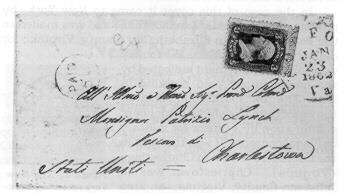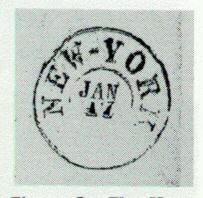

This article is from the May-June 1999 issue of the Confederate Philatelist. Posted with the permission of the journal editor.
The cover illustrated here is an example of an attempt to deliver mail from a neutral nation, Italy, to a nation at war, the Confederacy, through the mail of its enemy, the United States.
 |
Figure 1 -- An 1862 Confederate Norfolk, Virginia postmark dated January 23 cancels a US 3c 1861 on this cover to Charlestown (Virginia). There is a light but clear strike of the Confederate PAID 5c marking on the left. Note the "Stati Uniti" (Italian for United States) in the address which indicates probable origin outside the United States.
From mid-May 1861 correspondence between the North and South had become increasingly difficult. In an effort to supply a need the Adams Express Company and the American Letter express Company had set up operations in Nashville TN and Louisville KY. Even though this operation had been declared illegal in May 1861 it wasn't until August 26, 1861 when President Lincoln finally stopped it for good with a government edict.
However, there was still considerable demand and need for a form of letter communication between the warring states. So the federal Government set up a system to exchange mail under military control on a daily basis. Mail was sent to Norfolk, Virginia in another envelope with some sort of payment to pay the cost of the other side's postal system. The outside envelope was then thrown away, the payment (money or stamp) used to forward the letter from there.
In the case of this cover it came to New York by regular mail from Italy (no blockade) and was mailed to Old Point Comfort in Elizabeth City County, Virginia for delivery to Norfolk where the money was taken and payment indicated by the handstamped paid marking in blue. The "ex" marking in pencil at the top of the cover shows evidence of examination by a censor for military or illegal contents. It was then put in the Confederate mail to Charlestown (Virginia). Charlestown was in Jefferson County, Virginia an area that had pro-Union sympathies and eventually seceded from Virginia to become part of West Virginia.
 |
Inside docketing on this cover indicated that this cover was sent from Rome, Italy on August 30, 1861. It is obvious that even though open hostilities between the states had been going on for only a few months, the sender had a working knowledge of the mailing procedures. Although this method was difficult it would remain in effect largely intact until the end of the war. However, this particular routing would remain in operation for only a few months as Norfolk was captured by the Federals on May 10, 1862 and the exchange site was moved to City Point VA just below Richmond on the James River.
This cover is a classic example of using the legal mailing methods in place as opposed to blockade run or sneaking it across the border to ensure that a message reached its intended destination.
References:

 Return to Top of Page
Return to Top of Page 
